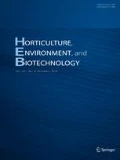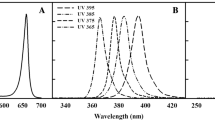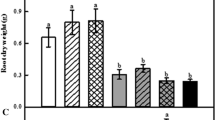Abstract
The ice plant (Mesembryanthemum crystallinum L.), widely known to be an effective cure for diabetes mellitus, is also a functional crop. This study was conducted to examine the effects of light quality and intensity of monochromatic light-emitting diodes (LEDs) on ice plant growth and phytochemical concentrations in a closed-type plant production system. Ice plant seedlings were transplanted into a deep floating technique system with a recycling nutrient solution (EC 4.0 dS m−1, pH 6.5). Fluorescent lamps, as well as monochromatic red (660 nm) and blue (450 nm) LEDs, were used at 120 ± 5 or 150 ± 5 µmol m−2 s−1 PPFD with a photoperiod of 14 h/10 h (light/dark) for 4 weeks. Ice plants showed higher growth under the high light intensity treatment, especially under the red LEDs. Furthermore, the SPAD value and photosynthetic rate were higher under the red LEDs with 150 µmol m−2 s−1 PPFD. The ice plant phytochemical composition, such as antioxidant activity and myo-inositol and pinitol concentrations, were highest under the blue LEDs with 150 µmol m−2 s−1 PPFD. Total phenolic concentration was highest under the blue LEDs with 120 µmol m−2 s−1 PPFD. Despite a slightly different dependence on light intensity, phytochemical concentrations responded positively to the blue LED treatments, as compared to other treatments. In conclusion, this study suggests that red LEDs enhance ice plant biomass, while blue LEDs induce phytochemical concentrations.





Similar content being viewed by others
References
Abinaya M, Prabhakaran S, Nur H, Ko CH, Jeong BR (2015) Blue LED light enhances growth, phytochemical contents, and antioxidant enzyme activities of Rehmannia glutinosa cultured in vitro. Hortic Environ Biotechnol 56:105–113
Adams P, Thomas JC, Vernon DM, Bohnert HJ, Jensen RG (1992) Distinct cellular and organismic responses to salt stress. Plant Cell Physiol 33:1215–1223
Adams P, Nelson DE, Yamada S, Chmara W, Jensen RG, Bohnert HJ, Griffiths H (1998) Growth and development of Mesembryanthemum crystallinum (Aizoaceae). New Phytol 138:171–190
Agarie S, Kawaguchi A, Kodera A, Sunagawa H, Kojima H, Nose A, Nakahara T (2009) Potential of the common ice plant, Mesembryanthemum crystallinum as a new high-functional food as evaluated by polyol accumulation. Plant Prod Sci 12:37–46
Barnes C, Bugbee B (1992) Morphological responses of wheat to blue light. J Plant Physiol 139:339–342
Bohnert HJ, Cushman JC (2000) The ice plant cometh: lessons in abiotic stress tolerance. J Plant Growth Regul 19:334–346
Bohnert HJ, Nelson DE, Jensen RG (1995) Adaptations to environmental stresses. Plant Cell 7:1099–1111
Brown CS, Schuerger AC, Sager JC (1995) Growth and photomorphogenesis of pepper plants under red light-emitting diodes with supplemental blue or far-red lighting. J Am Soc Hortic Sci 120:808–813
Casal JJ, Smith H (1988) The loci of perception for phytochrome control of internode growth in light-grown mustard: promotion by low phytochrome photoequilibria in the internode is enhanced by blue light perceived by the leaves. Planta 196:277–282
Cha MK, Cho JH, Cho YY (2013) Growth of leaf lettuce as affected by light quality of LED in closed-type plant factory system. Prot Hortic Plant Fact 22:291–297
Choi MK, Baek GY, Kwon SJ, Yoon YC, Kim HT (2014) Effect of LED light wavelength on lettuce growth, vitamin C and anthocyanin contents. Prot Hortic Plant Fact 23:19–25
Deitzer GF, Hayes R, Jabben M (1979) Kinetics and time dependence of the effect of far red light on the photoperiodic induction of flowering in ‘Wintex barley’. Plant Physiol 64:1015–1021
Dixon RA, Paiva NL (1995) Stress-induced phenylpropanoid metabolism. Plant Cell 7:1085–1097
Downs RJ (1956) Photoreversibility of flower initiation. Plant Physiol 31:279–284
Ebisawa M, Shoji K, Kato M, Shimomura K, Goto F, Yoshihara T (2008) Supplementary ultraviolet radiation B together with blue light at night increased quercetin content and flavonol synthase gene expression in leaf lettuce (Lactuca sativa L.). Environ Control Biol 46:1–11
Engelsma G, Meijer G (1965) The influence of light of different spectral regions on the synthesis of phenolic compounds in gherkin seedlings in relation to photomorphogenesis II. Indoleacetic acid oxidase activity and growth. Acta Bot Neerl 14:73–92
Gu EJ, Kim DW, Jang GJ, Song SH, Lee JI, Lee SB, Kim BM, Cho YR, Lee HJ et al (2017) Mass-based metabolomic analysis of soybean sprouts during germination. Food Chem 217:311–319
Heinonen IM, Lehtonen PJ, Hopia AI (1998) Antioxidant activity of berry and fruit wines and liquors. J Agric Food Chem 46:25–31
Heo JW, Kim DE, Han KS, Kim SJ (2013) Effect of light quality control on growth of Ledebouriella seseloides grown in plant factory of an artificial light type. Korean J Environ Agric 32:193–200
Johkan M, Shoji K, Goto F, Hashida S, Yoshihara T (2010) Blue light-emitting diode light irradiation of seedlings improves seedling quality and growth after transplanting in red leaf lettuce. HortScience 45:1809–1814
Kang MJ, Kim JI, Yoon SY, Kim JC, Cha IJ (2006) Pinitol from soybeans reduces postprandial blood glucose in patients with type 2 diabetes mellitus. J Med Food 9:182–186
Kang JH, Krishnakumar S, Atulba SLS, Jeong BR, Hwang SJ (2013) Light intensity and photoperiod influence the growth and development of hydroponically grown leaf lettuce in a closed-type plant factory system. Hortic Environ Biotechnol 54:501–509
Kim YJ, Kim HM, Hwang SJ (2016) Growth and phytochemical contents of ice plant as affected by light quality in a closed-type plant production system. Korean J Hortic Sci Technol 34:878–885
Kim HM, Kim HM, Lee HR, Lee JE, Hwang SJ (2017) Growth and phytochemical contents of spinach as affected by different type of fluorescent lamp in a closed-type plant production system. Prot Hortic Plant Fact 26:386–392
Kozai T, Koto H, Nakayama C, Nozue M, Nishina H, Taniguchi A, Takachuzi M, Murase H, Sugimoto K et al (2011) Cultivation of ice plant. In: Nam SY, So CH, Cho GH (eds) Industrial of agriculture. RGB Press, Seoul, pp 135–143
Lee JS, Kim YH (2014) Growth and anthocyanins of lettuce grown under red or blue light-emitting diodes with distinct peak wavelength. Korean J Hortic Sci Technol 32:330–339
Lee SY, Choi HD, Yu SN, Kim SH, Park SK, Ahn SC (2015) Biological activities of Mesembryanthemum crystallinum (ice plant) extract. J Life Sci 25:638–645
Lin KH, Huang MY, Huang WD, Hsu MH, Yang ZW, Yang CM (2013) The effects of red, blue, and white light-emitting diodes on the growth development, and edible quality of hydroponically grown lettuce (Lactuca sativa L. var. capitata). Sci Hortic 150:86–91
Matsuda R, Yamano T, Murakami K, Fujiwara K (2016) Effects of spectral distribution and photosynthetic photon flux density for overnight LED light irradiation on tomato seedling growth and leaf injury. Sci Hortic 198:363–369
Morgan DC, Smith H (1979) A systematic relationship between phytochrome-controlled development and species habitat, for plants grown in simulated natural radiation. Planta 145:253–258
Narayanan CR, Joshi DD, Mujumdar AM, Dhekne VV (1987) Pinitol: a new antidiabetic compound from the leaves of Bougainvillea spectabilis. Curr Sci 56:139–141
Nishimura T, Ohyama K, Goto E, Inagaki N (2009) Concentrations of perillaldehyde, limonene, and anthocyanin of Perilla plants as affected by light quality under controlled environments. Sci Hortic 122:134–137
Niu G, Fujiwara K (2016) Light: physical properties of light and its measurement, light sources. In: Kozai T, Niu G, Takagaki M (eds) Plant factory: an indoor vertical farming system for efficient quality food production. Academic Press, San Diego, pp 115–127
Nobel PS (2009) Light: light absorption by chlorophyll. In: Nobel PS (ed) Physicochemical and environmental plant physiology, 4th edn. Academic Press, Oxford, pp 199–201
Ohashi-kaneko K, Takase M, Kon N, Fujiwara K, Kurata K (2007) Effect of light quality on growth and vegetable quality in leaf lettuce, spinach and komatsuna. Envrion Control Biol 45:189–198
Park JE, Park YG, Jeong BR, Hwang SJ (2012) Growth and anthocyanin content of lettuce as affected by artificial light source and photoperiod in a closed-type plant production system. Korean J Hortic Sci Technol 30:673–679
Paul MJ, Cockburn W (1989) Pinitol, a compatible solute in Mesembryanthemum crystallinum L. J Exp Bot 40:1093–1098
Saebo A, Krekling T, Appelgren M (1995) Light quality affects photosynthesis and leaf anatomy of birch plantlets in vitro. Plant Cell Tissue Organ Cult 41:177–185
Shimizu H, Saito Y, Nakashima H, Miyasaka J, Ohdoi K (2011) Light environment optimization for lettuce growth in plant factory. Paper presented at the 18th IFAC World Congress, Milano, Italy, September 2011, pp 605–609
Singleton VL, Rossi JA (1965) Colorimetry of total phenolics with phosphomolybdic-phosphotungstic acid reagents. Am J Enol Viticult 16:144–158
Son KH, Park JH, Kim DI, Oh MM (2012) Leaf shape index, growth, and phytochemicals in two leaf lettuce cultivars grown under monochromatic light-emitting diodes. Korean J Hortic Sci Technol 30:664–672
Stutte GW, Edney S, Skerritt T (2009) Photoregulation of bioprotectant content of red leaf lettuce with light-emitting diodes. HortScience 44:79–82
Velioglu YS, Mazza G, Gao L, Oomah BD (1998) Antioxidant activity and total phenolics in selected fruits, vegetables, and grain products. J Agric Food Chem 46:4113–4117
Wang H, Gu M, Cui J, Shi K, Zhou Y, Yu J (2009) Effects of light quality on CO2 assimilation, chlorophyll-fluorescence quenching, expression of Calvin cycle genes and carbohydrate accumulation in Cucumis sativus. J Photochem Photobiol B Biol 96:30–37
Winter K, Willert DJV (1972) NaCl induced crassulacean acid metabolism in Mesembryanthemum crystallinum. J Physiol 67:166–170
Wu MC, Hou CY, Jiang CM, Wang YT, Wang CY, Chen HH, Chang HM (2007) A novel approach of LED light radiation improves the antioxidant activity of pea seedlings. Food Chem 101:1753–1758
Yamaguchi T, Takamura H, Matoba T, Terao J (1998) HPLC method for evaluation of the free radical scavenging activity of foods by using 1,1-diphenyl-2-picrylhydrazyl. Biosci Biotechnol Biochem 62:1201–1204
Zhang DH, Wang QP, Xue ZY (2003) Photoluminescence of ZnO films excited with light of different wavelength. Appl Surf Sci 207:20–25
Acknowledgements
This research was supported by the Cooperative Research Program for Agriculture Science and Technology Development for Rural Development Administration, Republic of Korea (Project No. PJ01277301).
Author information
Authors and Affiliations
Corresponding author
Rights and permissions
About this article
Cite this article
Kim, Y.J., Kim, H.M., Kim, H.M. et al. Ice plant growth and phytochemical concentrations are affected by light quality and intensity of monochromatic light-emitting diodes. Hortic. Environ. Biotechnol. 59, 529–536 (2018). https://doi.org/10.1007/s13580-018-0058-3
Received:
Revised:
Accepted:
Published:
Issue Date:
DOI: https://doi.org/10.1007/s13580-018-0058-3




